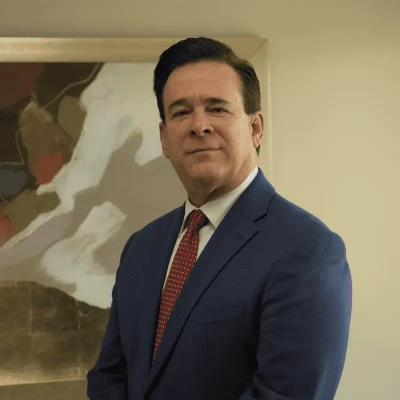25 Surprising Leadership Challenges When Growing a Small Business (And How to Overcome Them)"
Growing a small business presents unique leadership challenges that can make or break your company's success. This article shares expert insights on 25 surprising obstacles leaders face, from vulnerability and transparency to scalable systems and culture-building. Discover practical strategies to transform these challenges into opportunities for sustainable growth and team empowerment.
Lead Through Vulnerability to Encourage Risk-Taking
One of the leadership challenges that caught me by surprise as we were growing Eprezto was how important it is to create an environment where people feel safe to take risks, and how much of that depends on the leader being vulnerable.
In the early years, we ran many experiments to improve our product and grow faster. Some of those experiments failed, including a few that I personally proposed. I learned that when I openly acknowledged my own mistakes, saying, 'This one didn't work out, here's what we learned', it completely changed how the team responded.
Instead of being afraid to try new things, they became more willing to propose and test ideas. That culture of experimentation and openness has been a key driver of our growth.
My advice to new business owners is to lead by example in admitting when you're wrong. Vulnerability builds trust, lowers fear of failure, and encourages innovation. Your team will take bigger, smarter bets when they know mistakes won't be punished but will be treated as learning opportunities.

Balance Transparency with Direction During Uncertainty
One challenge I didn't anticipate was how quickly people turn to you for emotional steadiness, even in uncertain times. When we were scaling What Kind of Bug Is This, I had moments where I wasn't sure if a new strategy would work or if we'd hit our traffic goals. But I learned that if I showed too much doubt, the team would lose confidence fast.
To address this, I began being transparent about the unknowns while still presenting a clear plan. I'd say, "Here's what we know, here's what we're testing, and here's what we'll do next." That balance kept things real without rattling people. My advice? You don't need to fake certainty, but you do need to lead with direction — people can handle risk if they know you've thought it through.
Build Scalable Systems Before Problems Arise
When I first began scaling my business, I was completely unprepared for the operational chaos that resulted from trying to handle every function manually. The lack of systems led to missed deadlines, customer complaints, and significant team confusion that threatened our growth trajectory. I overcame this challenge by systematically documenting our core processes, implementing automation for repeatable tasks, and developing a delegation framework that matched team strengths with business needs. My advice to new business owners would be to build scalable systems from the beginning rather than waiting until problems arise, as proper infrastructure will save both time and reputation.
Prioritize Recruiting and Culture for Team Success
One leadership challenge I faced when growing my small business that caught me by surprise was the difficulty in finding good workers. As the business expanded, attracting and retaining skilled, reliable employees became increasingly tough. To overcome this, I focused on building a strong company culture, offering competitive wages, and creating opportunities for growth and development. I also improved our hiring process to better identify candidates who aligned with our values and work ethic. My advice to new business owners is to prioritize creating an attractive workplace environment and invest time in recruiting and training to build a dependable team. Good employees are essential to long-term success, so don't underestimate the importance of hiring and retaining the right people.
Maintain Mission Focus Amid Rapid Growth
As Legacy Online School began achieving rapid growth, I found the biggest challenge, which I hadn't thought about beforehand, was not marketing or operations, it was remaining human. Suddenly, we had people joining us from ten different countries, and I was learning just how quickly and easily we could lose the "why" in what we were building as everyone was working remotely.
At one point, I observed that our meetings had turned into all about metrics. Numbers were good, perhaps better than good. But there was no spark. I had a moment of reflection where I thought, "We built this school so families would feel connected, and now even our own team feels disconnected." I reflected a little and decided that was on me.
So, I decided to slow things down. I started each of the all-hands with a true story, a student who was having a breakthrough, an email from a parent, a teacher who was proud of a moment. Then I invited our team to share their moments. It seems simple, but this changed everything and injected heart back into the work we were all doing.
So, my advice to founders is this. Growth can make you efficient, but efficiency without emotion kills culture. Keep your mission front and center of what you are doing every single day in the small moments. Remind your team the work they are doing is meaningful and important, and not just the task they are responsible for completing.

Overcome the Founder Bottleneck with Operating Systems
What was the most unexpected leadership challenge you encountered while expanding your small business?
I didn't realize "founder-as-bottleneck" would appear so soon. Decisions piled up at my desk as the team grew, resulting in slow cycles, erratic priorities, and a culture where people wait for approval rather than take responsibility for their own results.
How did you get past it?
I replaced ad hoc direction with a basic operating system: a weekly Operator's Letter that outlined three company priorities, what we're saying "no" to, and the metrics that matter; a written Decision Charter that outlines who makes decisions, by when, and with what inputs; and a two-page memo template for proposals. We added pre-mortems for major initiatives, implemented one-way vs. two-way door rules (irreversible vs. reversible) to push most decisions down to teams, and monitored revenue along with two key indicators: time-to-decision and cycle time. In a matter of weeks, managers stopped passing routine decisions through me, meetings grew shorter, and handoffs became cleaner.
What guidance would you offer aspiring entrepreneurs?
Jot it down beforehand. A dozen standing meetings are outweighed by a one-page cadence that includes weekly priorities, owners, and deadlines.
Not more dashboards, but design decision rights. For each important outcome, identify the directly responsible person (DRI) and give them the authority to choose two-way doors without resorting to escalation.
Assess speed as well as outcomes. Keep an eye on cycle time and time to decision; tardy choices are silent margin killers.
Put up guardrails. Establish "kill-switch" thresholds (budget, timeline, and quality) that, when triggered, cause the project to automatically pause.
Preserve concentration. Since written updates are more readable than Zoom ones, block out times when meetings are not in session.

Create Transparent Systems Rather Than Top-Down Control
One leadership challenge that really caught me off guard while growing Tutorbase was keeping quality consistent among gig tutors without traditional oversight. Day-to-day, fixing inconsistent performance almost always meant turning to transparent systems rather than top-down control. I introduced a peer feedback network and performance metrics that tutors could actually see and trust. It was awkward at first, but once people realized it helped them improve instead of just monitoring them, morale and results went up. My advice for new founders is to create tools that empower people instead of trying to control themit builds trust faster than any rulebook.

Hire for Character and Trust Your Team
It is truly valuable when a challenge forces you to grow into a stronger leader, because delegating is often the hardest, but most necessary, step for any small business. My biggest leadership challenge was letting go of the tools. The "radical approach" was a simple, human one.
The process I had to completely reimagine was my personal involvement in every job. When the business began to grow rapidly, my biggest challenge was the fear that no one else could match my quality standard. I realized that a good tradesman solves a problem and makes a business run smoother by being a leader, not just the best worker.
I overcame that challenge by formalizing our hiring with the Paid Trial Day. This intensive process allowed me to verify a potential hire's character and work ethic before trusting them with a client's main panel. The simple truth is, you can only overcome fear by building verifiable trust.
The biggest lesson I learned was that Trust is the Fastest Route to Growth. By focusing on character, I empowered my crew to take complete ownership of their work. This freed my time for quoting and management, allowing the business to scale without compromising quality.
My advice for new business owners is to hire for character, then trust the team. A job done right is a job you don't have to go back to. Don't let your own fear of letting go limit your business's potential. That's the most effective way to "overcome a challenge" and build a business that will last.

Protect Team Time Off Like Part of Job
The leadership challenge that surprised me most was learning how to manage burnout—my own and my team's. In the early growth years, we took every job that came our way. I thought saying yes to everything was what good leadership looked like. But within a year, I had techs running six days a week and morale slipping fast. Even I was running on fumes. Productivity didn't drop because people stopped caring; it dropped because everyone was exhausted.
The turning point came when we started protecting time off like it was part of the job. We built schedules that guaranteed two consecutive days off and stopped booking emergency jobs outside of designated hours. Within a few months, call-backs decreased and customer satisfaction went up because our team wasn't running on empty. My advice to other business owners is simple: growth doesn't mean saying yes to everything. Sometimes the best leadership move you can make is setting limits that let your people (and you) breathe.

Foster Remote Connection Beyond Task Management
The biggest leadership surprise for me was creating a tangible team culture when my entire operation is virtual, with assistants spread across the globe. Coming from restaurant jobs where you build camaraderie shoulder-to-shoulder, I had to learn to manufacture that connection remotely. I started hosting virtual team huddles focused purely on personal wins and connecting as people, not just colleagues, which transformed our dynamic. My advice is to over-invest in building human connection when your team is remote--it's the glue that holds a virtual business together and keeps everyone feeling like part of something bigger.

Show Value Through Action Not Sales Pitch
The biggest surprise was realizing how hard it would be to build trust in our hybrid investor-broker model - clients were skeptical about getting both services from one company. I overcame this by leaning into my construction expertise: during property tours, I'd physically point out overlooked issues like foundation cracks or wiring problems that could save them thousands, transforming skepticism into confidence. My advice? Make your unique value proposition visceral - show don't tell - because demonstrating tangible savings builds credibility faster than any sales pitch.

Systematize Your Values to Scale Successfully
The leadership challenge that caught me off guard was balancing growth with our family-first values. As we expanded into new markets, I found myself stretched thin and struggling to maintain the personal touch that defined our business. I overcame this by implementing a 'homeowner journey map' that documented every touchpoint in our process, ensuring each client received the same care regardless of who handled their case. My advice to new business owners is to systematize your values early--document exactly how your core principles translate into daily actions so that your business can scale without losing its heart and soul.

Build Strong Culture to Retain Top Talent
As the CEO and founder of ALP Heating LTD., I've faced numerous challenges while growing our small business, but one that truly caught me by surprise was the importance of building a strong company culture. Early on, I was primarily focused on the technical aspects of our HVAC services and ensuring we delivered high-quality installations and repairs. However, I quickly realized that our success hinged not only on our technical expertise but also on the people behind the tools.
In the HVAC industry, especially in the Greater Toronto Area, where competition is fierce, having a knowledgeable and skilled team is crucial. I found that fostering a positive work environment is key to retaining top talent and ensuring that our customers receive the best possible service. This realization hit me during a particularly busy winter season when our team was stretched thin. We faced not only a high volume of service requests but also the challenge of keeping morale up while ensuring safety and quality service.
To overcome this, I initiated regular team meetings to openly discuss our challenges and celebrate our successes. We implemented a mentorship program where experienced technicians could guide newer team members, reinforcing both skills and a sense of camaraderie. Additionally, we focused on recognizing individual contributions, which fostered pride in our work and loyalty to ALP Heating.
My advice to new business owners is to prioritize company culture from the start. Invest time in your team, listen to their feedback, and create an environment where everyone feels valued and supported. This approach not only enhances employee satisfaction but also translates into better customer experiences. Remember, a happy team provides the foundation for a successful business.
Moreover, don't hesitate to adapt and evolve your strategies as your business grows. What works in the early stages may need refinement as you scale. At ALP Heating, we continuously seek feedback from both our team and our customers, allowing us to adapt our services and maintain our commitment to excellence.
Ultimately, the journey of entrepreneurship is filled with unexpected lessons, but focusing on your team and nurturing a positive culture can lead to rewarding outcomes, both for your business and your clients.

Cultivate Clarity Through Daily Practice and Rituals
One leadership challenge that caught me by surprise was realizing that clarity isn't automatic... not for me, and not for my team.
When I first started OG Solutions, I thought if I set the vision clearly once, everyone would naturally follow along. But what I learned quickly is that clarity has to be cultivated every day. Without it, even talented people can spin in different directions, and as a leader you end up carrying the weight of everyone's confusion.
The surprise was how much time and energy it took to keep the vision visible. I assumed people would "just get it," but they didn't. That was on me.
How I overcame it: I stopped treating clarity like a one-time announcement and started treating it like a practice. I began every project with a grounding question: What are we really trying to achieve here, and how will we know when we've done it? I repeated this in team meetings, in client briefings, even in emails. Over time, it became a cultural habit.
What shifted for me as a leader was understanding that people don't just need direction. They need reminders, rituals, and reflection to stay aligned. That's what frees them up to be creative and resourceful.
My advice for new business owners: Don't underestimate how much clarity matters, and don't assume people can read your mind. Spell out the vision. Repeat it until you're tired of hearing yourself say it, because only then is it sinking in. Build small rituals that reinforce it, like weekly check-ins, kickoff questions, or even visual reminders.
Clarity isn't about being perfect or polished. It's about creating the conditions where your people know what matters most, and they can move with confidence. Once I embraced that, my team became more autonomous, our projects flowed smoother, and I could finally step back and lead instead of firefight.

Define Clear Decision Frameworks Around Core Values
One leadership challenge that really took me by surprise was the emotional complexity of saying 'no' to potential deals or clients that didn't align with our ethical standards. Early on, I'd feel torn between business growth opportunities and our core principles--like when we walked away from a multi-property contract because the seller needed more support than we could honestly provide. I overcame this by making our 'unmatch criteria' crystal clear in weekly meetings and role-playing those tough conversations. My advice to new owners? Build decision-making frameworks around your non-negotiables; when you consistently honor your values in difficult moments, it actually attracts the right clients and builds your team's trust in leadership.

Establish Objective Performance Metrics From Day One
One leadership challenge that genuinely surprised me was the emotional toll involved in making tough decisions that impacted my team, especially when it meant letting someone go. As someone who values building relationships in our community, balancing business needs with empathy was difficult. I overcame this by developing a structured, fair process for evaluating performance and providing clear feedback, which helped depersonalize the decision-making while still maintaining compassion. My advice to new owners: prioritize having clear, objective performance metrics in place from day one--it protects both you and your team when difficult choices inevitably arise.
Empower Team Decision-Making Beyond Command Structures
The most surprising leadership challenge I faced was transitioning from a military mindset of direct command to the more nuanced leadership required in business ownership. As a 14-year Army veteran, I was accustomed to clear chains of command, but I discovered that leading employees and contractors required building buy-in rather than giving orders. I overcame this by creating decision-making frameworks that gave my team autonomy while maintaining our standards of integrity. My advice to new business owners: recognize that effective business leadership often means stepping back and empowering others--when you stop being the bottleneck for every decision, you create space for both your team and business to grow.

Develop Internal Leadership to Maintain Quality
A leadership challenge that I was not prepared for was ensuring that the programs we were growing to meet the needs of our patients in the home were coordinated between the various patients. As the business expanded, it was becoming increasingly challenging to deliver the level of personalised care that each client was entitled to while training more staff and running the business. It got more complex when we had to incorporate new technologies to ease our processes without affecting the quality of service.
I overcame this challenge by investing in the training and development of leadership in my team. I was firm in communicating to each manager and team member the high standards that we set and the importance of patient care as a key to our success. I also drew from my experience as an instructor pilot in the Navy to teach my team how to be adaptable and operate as a team under pressure. My advice to new business owners is to invest in good internal leadership, and to invest in ongoing training, so that your team is ready to handle growth while maintaining the quality.

Actively Invite Problems Before They Become Crises
The leadership challenge that completely caught me off guard at VoiceAIWrapper was when my team started avoiding bringing me problems, even though I thought I had created an open, collaborative environment.
I discovered this during what should have been a routine project update. Our lead developer mentioned, almost in passing, that a customer integration had been failing for three days. When I asked why I hadn't heard about it sooner, the response was eye-opening: "You seemed busy with the investor presentations, so we figured we'd handle it."
This revealed a pattern I hadn't recognized. As we grew and I took on more external responsibilities - investor meetings, partnership discussions, strategic planning - my team had started treating me as too important to bother with operational issues.
The surprise wasn't that problems existed, but that my attempt to focus on "high-level" leadership had inadvertently created distance from day-to-day challenges. I thought delegation meant stepping back from details, but my team interpreted this as unavailability for problem-solving.
The solution required intentionally creating "problem invitation" rather than waiting for issues to escalate. I implemented weekly "challenge sessions" where team members specifically shared obstacles, frustrations, and early warning signs without needing solutions or decisions from me.
More importantly, I started explicitly asking about problems during casual interactions: "What's the most frustrating thing you're dealing with this week?" or "What problem are you hoping will resolve itself?"
This approach transformed team communication. Instead of protecting me from problems, people began sharing challenges when they were still manageable rather than waiting until they became crises.
The key insight was that leadership visibility requires intentional effort as companies grow. The natural evolution toward higher-level responsibilities can accidentally create barriers to ground-level awareness.
My advice for new business owners: as you grow, actively maintain connection to operational realities. Your team's willingness to bring you problems is actually a sign of healthy leadership, not a burden to avoid.
The most dangerous leadership mistake is becoming so focused on strategic responsibilities that you lose touch with the daily challenges your team faces.

Hire for Commitment and Measure Output
Running a remote team, I underestimated how easy it is to look busy without moving the ball. The real challenge wasn't tools or time zones - it was full buy-in. I solved it by hiring and managing for commitment, not convenience: we added a values interview, a paid trial project, and a 90-day scorecard with clear, output-based goals. Everyone shares short weekly priorities, posts quick video updates on progress, and we celebrate visible wins. If effort or attitude slips, we address it immediately - remote only works when the whole team leans in. My advice: make buy-in non-negotiable, hire for energy and ownership, measure output (not online time), and don't hesitate to part ways when it's not a fit. The right people will be excited to work with you and will show it in their results.

Replace Entire Roles With AI, Not Just Tasks
Dear Editor,
The hardest part wasn't scaling operations or raising capital—it was realizing I couldn't clone myself. As a solopreneur, every role fell on my shoulders: sales calls, customer support, operations, strategy. I'd finish one task only to find three more waiting. The bottleneck wasn't my skills—it was my time.
What caught me by surprise was how traditional automation didn't solve this. Task automation helped with repetitive work, but it couldn't handle the nuanced stuff—having conversations with prospects, answering customer questions with context, or managing follow-ups that required judgment calls.
The breakthrough came when I stopped thinking about automating tasks and started thinking about replacing entire roles with AI. Instead of just scheduling emails, I implemented AI voice agents that could handle full customer interactions, qualify leads, and even manage support queries with the kind of responsiveness I could never maintain alone. These weren't just tools executing commands—they were functioning as actual team members.
My advice: Don't get stuck in the task automation mindset. Look at your day and ask which entire roles are consuming your energy, not just which tasks are repetitive. The technology exists now to have AI handle complete functions—customer conversations, appointment setting, initial consultations.
Start thinking about building a workforce, not just implementing tools. Your growth shouldn't be limited by how many hours you personally have in a day.
Stefano Bertoli
Founder & CEO
ruleinside.com
RuleInside | Managed AI Workforce

Address Difficult Conversations Early and Directly
Hello!
One leadership challenge I have faced is over what to do when a co-founder isn't pulling his weight equal to his equity. I realized after almost a year of ignoring it that something had to be done. I ended up documenting the areas where I felt he wasn't putting in enough effort, and give him multiple opportunities to improve. However, over time it become too much and we had to have the heart to heart conversation about his equity. While reluctant, he eventually agreed that the equity would be better used to hire someone to take over the job he was struggling to fulfill.
As advise, I'd say to get out in front of situations that you know are trending in a direction. If you know you need to pull a trigger and have an uncomfortable situation, don't avoid it, as it only becomes worse over time!
Greg Gerla
CEO, Stride Soles
Embrace Patience During Slow Initial Growth
Learning to overcome the slow growth of starting a small business is critical. So many small businesses fail in their first year because people underestimate how hard it is to make money and start a business from scratch. I've had to become extremely patient, determined and perseverant in the face of slow initial growth. Good things take time to build from scratch, and new business owners will need to hold on to their "why" so that when they face doubt or setbacks, they can power through to the other side. Startup business growth is slower than we'd like.

Communicate More Than You Think Necessary
One leadership challenge that truly caught me by surprise was realizing how communication changes as a team grows. When it was just a few of us, everyone knew what was happening because we were in constant contact. But as we hired more people, small misunderstandings started turning into big issues. I assumed everyone shared the same priorities, but without consistent structure, things slipped through the cracks.
To fix it, I built a rhythm of communication. We introduced weekly syncs, clear reporting systems, and short check-ins that focus on alignment instead of micromanagement. I also started sharing more context why we were doing something, not just what to do. Once the team understood the reasoning behind decisions, their execution improved dramatically.
The lesson I learned is that leadership during growth is about clarity, not control. You can have the best strategy in the world, but if your team doesn't feel connected to it, execution suffers. My advice to new business owners is simple: communicate twice as much as you think you need to. When your team feels seen, informed, and trusted, they will move faster and make better decisions even when you are not in the room.
Stay True to Your Company Ethos
We're a web development company and when we were growing our team, we suddenly hit a patch where we had more people, but we weren't billing any more. Growing the team had been growing our profit, but suddenly, we hit a patch where our profit stagnated despite taking on extra people. We were reassured though by our accountant who told us it was common for small businesses to hit this pinch point before coming out the other side bigger. We got through it by deviating from the typical agency model of having account handlers/managers, and focused on employing developers - the ones with the best billable hours - who were also strong communicators with pragmatic business sense, so we could avoid the "overhead" of people just passing messages to clients. The downside is our team still - on paper - appears small to some potential clients, when we know our throughput is good. So we've just made our peace with the fact that the clients who suit us best appreciate that the size of the team isn't what's important, it's the service and experience that matters. Therefore my overall advice would be to keep doing what suits your company ethos best, and find the customers or clients who work that way too, as it'll make for great long term relationships.








